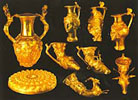 |
Panagyurishte Golden Treasure |
 |
 The Panagyurishte Golden Treasure is a rare archaeological monument from the Hellenistic Age and one of the symbols of the Panagyurishte region. It was found near the Mramor hillock in 1949 during agricultural work. It consists of nine richly adorned vessels - an amphora, seven rhytons and a phial. It weighs 6.164 kg. The largest vessel is the amphora, which has a centaur-shaped handle. Three of the seven rhytons are shaped as animals' heads, one is the front part of a goat, three have women's (Amazon) heads. The set most probably served for the drinking of wine in a religious, celebratory or domestic atmosphere. There is also an opinion that its purpose was the ritual purification of a liquid, which could be wine. It is supposed that another two rhytons with the front part of animals, an amphora and one or two phials are missing, with a view of the sacral importance of the number three in the Thracian religion. There exist two basic hypotheses about the origin of the Panagyurishte Treasure. They are based on the carved letters on some of the vessels, which are considered to signify the measure units of the gold. According to a widespread thesis, the signs belong to the metric system used in the Asia Minor town Lampsak. Other scholars however have discovered that a similar system was used in the interior of Thrace, so there is a possibility of the treasure's local origin.
The Panagyurishte Golden Treasure is a rare archaeological monument from the Hellenistic Age and one of the symbols of the Panagyurishte region. It was found near the Mramor hillock in 1949 during agricultural work. It consists of nine richly adorned vessels - an amphora, seven rhytons and a phial. It weighs 6.164 kg. The largest vessel is the amphora, which has a centaur-shaped handle. Three of the seven rhytons are shaped as animals' heads, one is the front part of a goat, three have women's (Amazon) heads. The set most probably served for the drinking of wine in a religious, celebratory or domestic atmosphere. There is also an opinion that its purpose was the ritual purification of a liquid, which could be wine. It is supposed that another two rhytons with the front part of animals, an amphora and one or two phials are missing, with a view of the sacral importance of the number three in the Thracian religion. There exist two basic hypotheses about the origin of the Panagyurishte Treasure. They are based on the carved letters on some of the vessels, which are considered to signify the measure units of the gold. According to a widespread thesis, the signs belong to the metric system used in the Asia Minor town Lampsak. Other scholars however have discovered that a similar system was used in the interior of Thrace, so there is a possibility of the treasure's local origin.
|

 Last Issue
Last Issue

 Subscribe NOW!
Subscribe NOW!
 Български
Български

 The Panagyurishte Golden Treasure is a rare archaeological monument from the Hellenistic Age and one of the symbols of the Panagyurishte region. It was found near the Mramor hillock in 1949 during agricultural work. It consists of nine richly adorned vessels - an amphora, seven rhytons and a phial. It weighs 6.164 kg. The largest vessel is the amphora, which has a centaur-shaped handle. Three of the seven rhytons are shaped as animals' heads, one is the front part of a goat, three have women's (Amazon) heads. The set most probably served for the drinking of wine in a religious, celebratory or domestic atmosphere. There is also an opinion that its purpose was the ritual purification of a liquid, which could be wine. It is supposed that another two rhytons with the front part of animals, an amphora and one or two phials are missing, with a view of the sacral importance of the number three in the Thracian religion. There exist two basic hypotheses about the origin of the Panagyurishte Treasure. They are based on the carved letters on some of the vessels, which are considered to signify the measure units of the gold. According to a widespread thesis, the signs belong to the metric system used in the Asia Minor town Lampsak. Other scholars however have discovered that a similar system was used in the interior of Thrace, so there is a possibility of the treasure's local origin.
The Panagyurishte Golden Treasure is a rare archaeological monument from the Hellenistic Age and one of the symbols of the Panagyurishte region. It was found near the Mramor hillock in 1949 during agricultural work. It consists of nine richly adorned vessels - an amphora, seven rhytons and a phial. It weighs 6.164 kg. The largest vessel is the amphora, which has a centaur-shaped handle. Three of the seven rhytons are shaped as animals' heads, one is the front part of a goat, three have women's (Amazon) heads. The set most probably served for the drinking of wine in a religious, celebratory or domestic atmosphere. There is also an opinion that its purpose was the ritual purification of a liquid, which could be wine. It is supposed that another two rhytons with the front part of animals, an amphora and one or two phials are missing, with a view of the sacral importance of the number three in the Thracian religion. There exist two basic hypotheses about the origin of the Panagyurishte Treasure. They are based on the carved letters on some of the vessels, which are considered to signify the measure units of the gold. According to a widespread thesis, the signs belong to the metric system used in the Asia Minor town Lampsak. Other scholars however have discovered that a similar system was used in the interior of Thrace, so there is a possibility of the treasure's local origin.